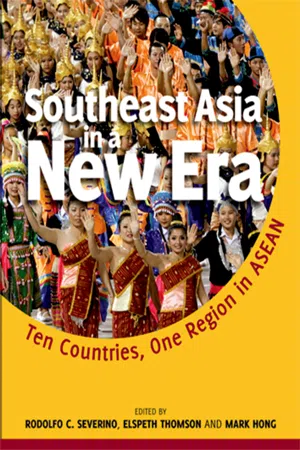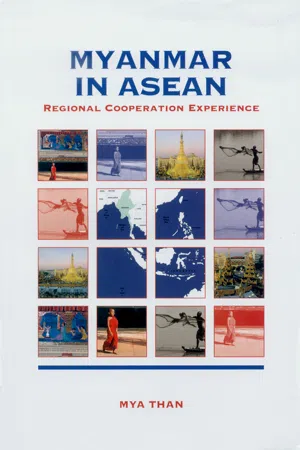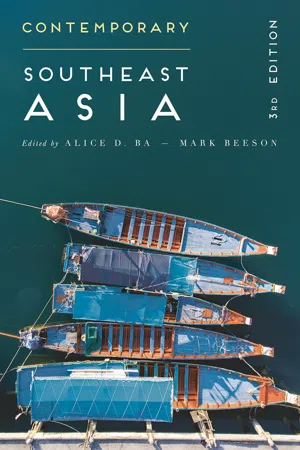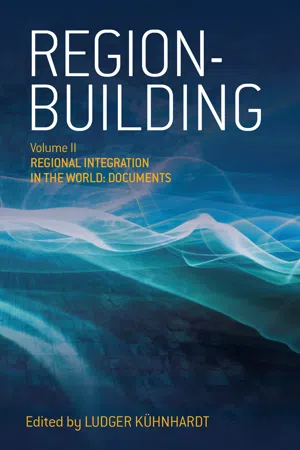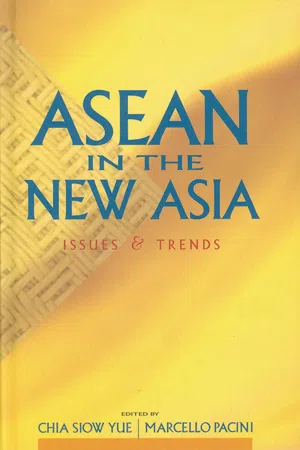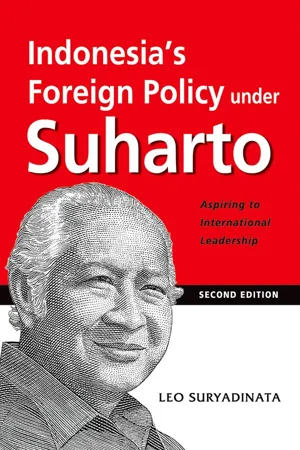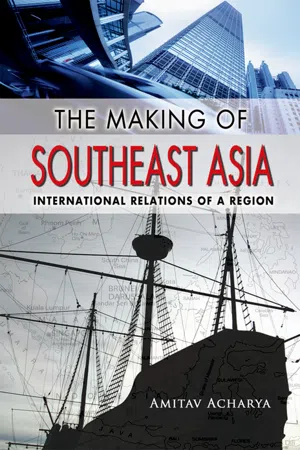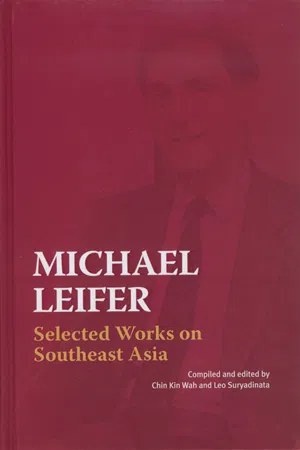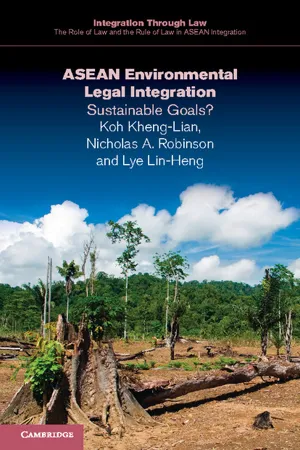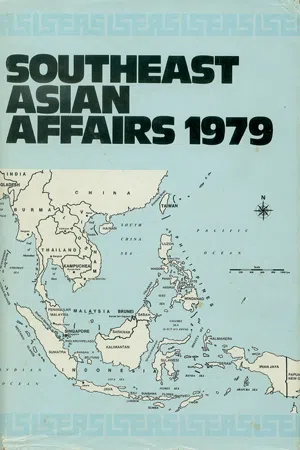Geography
ASEAN
ASEAN, or the Association of Southeast Asian Nations, is a regional intergovernmental organization comprising ten Southeast Asian countries. It aims to promote political and economic cooperation and regional stability. ASEAN member states work together on issues such as trade, security, and cultural exchange, and the organization plays a significant role in shaping the geopolitical landscape of Southeast Asia.
Written by Perlego with AI-assistance
Related key terms
1 of 5
12 Key excerpts on "ASEAN"
- eBook - PDF
Southeast Asia in a New Era
Ten Countries, One Region in ASEAN
- Rodolfo C. Severino, Elspeth Thomson, Mark Hong(Authors)
- 2009(Publication Date)
- ISEAS Publishing(Publisher)
241 Rodolfo C. Severino No discussion of Southeast Asia as a region is complete without touching on the Association of Southeast Asian Nations, or ASEAN. ASEAN is the institu-tion that has brought the countries of Southeast Asia together. It is ASEAN that deals with the world on behalf of Southeast Asia as a whole. Through its activ-ities, ASEAN has promoted mutual confidence among its member states and their peoples and built networks of friendship and cooperation among them. Through its norms for inter-state relations and the habits of consultation and dialogue that it fosters, ASEAN has helped keep the region peaceful and stable. ASEAN has been the main institutional vehicle for integrating the regional economy. It has provided a framework for the nations and peoples of South-east Asia to cooperate in dealing with such common threats as environmental degradation, communicable diseases, international terrorism, and transnation-al crime. The links between ASEAN and other countries have strengthened those countries’ ties with individual ASEAN members as well as the fabric of peace and cooperation in the region and in the world. ASEAN has been the hub and convener of the regionalization process in East Asia and beyond. ASEAN was founded on 8 August 1967, when the foreign ministers of Indonesia, Malaysia, the Philippines, Singapore and Thailand signed the ASEAN Declaration in Bangkok. The two-page document set forth the Association’s objectives as economic growth, social progress, cultural development, peace and stability, and cooperation for common purposes in a broad range of areas. REGIONAL PEACE AND STABILITY The overriding purpose of the new Association, however, was to ensure that disputes among its members did not develop into conflict and that the 12 The Association of Southeast Asian Nations SOUTHEAST ASIA IN A NEW ERA: Ten Countries, One Region in ASEAN 242 region was kept out of the quarrels of the great powers. - eBook - PDF
Myanmar in ASEAN
Regional Cooperation Experience
- Mya Than(Author)
- 2005(Publication Date)
- ISEAS Publishing(Publisher)
Now, ASEAN has become the only organization which represents all 10 Southeast Asian nations. And this stage can be considered as the fourth phase of regional cooperation in Southeast Asia. Since the formation of ASEAN, peace and stability have substantially improved in the region. 2 Also, economic and cultural relations among the member nations have improved. Moreover, since there is peace and stability in the region and ASEAN’s credibility is firmly established, its role in international cooperation progresses — politically and economically. It has now been more than 35 years since ASEAN was established and cooperation has widened and deepened. It is expected that Timor Leste, Australia and New Zealand may join ASEAN. In fact, China and India have already signed the ASEAN Treaty of Amity and Cooperation (TAC) in 2003 at the Bali Summit and Japan has pledged to follow suit. Moreover, ASEAN countries are advocates of open regionalism, simply because the region is too small for inward-looking regionalism. In reality, ASEAN is the world’s largest free trade area (FTA) grouping in terms of population, but the smallest in terms of GDP. Therefore, it is building external linkages with Asia-Pacific Economic Cooperation (APEC), Australia and New Zealand Closer Economic Relations Trade Agreement (CER), the European Union (EU), North American Free Trade Association (NAFTA), and other organizations. ASEAN and China have already agreed to form 14 ASEAN: EVOLUTION OF REGIONAL COOPERATION IN SOUTHEAST ASIA a free trade area (FTA) in 2010. Apart from this country-related widening, a broadening of issues is underway, covering investment, cross-border spillovers such as environmental protection, cross-border crime control, meteorological research, natural disaster prevention, anti-terrorism and emergency relief. ASEAN has also deepened its economic, political, social and security cooperation. - eBook - PDF
Contemporary Southeast Asia
The Politics of Change, Contestation, and Adaptation
- Alice D. Ba, Mark Beeson, Alice D. Ba, Mark Beeson(Authors)
- 2017(Publication Date)
- Red Globe Press(Publisher)
146 Chapter 9 Regionalism and Southeast Asia Mathew Davies Introduction Perhaps no other regional organization is as much debated as the Associa-tion of Southeast Asian Nations (ASEAN). Founded in 1967 by Indonesia, Malaysia, Singapore, the Philippines and Thailand, ASEAN has been acclaimed by some as a vehicle for securing regional peace and security, and by others as almost completely irrelevant, characterized by meaningless commitments that are ignored by its members. The purpose of this chapter is not to take one side or the other in these debates, but instead to equip the reader with the necessary information to make up their own minds about the nature and value of ASEAN in Southeast Asia; I am neither ASEAN’s defender nor its prosecutor. To assist in this process, this chapter begins from the position that to engage in criticism, or praise, of ASEAN requires an appreciation of the context in which decision-makers found themselves, and an analysis of why those decisions were thought to be appropriate solutions at the time. In taking this approach, I hope to aid the reader in distinguishing between criticizing ASEAN on the basis of what it can do, what it was designed to do and what we may wish it to do. To begin with, I outline why regionalism was viewed as a suitable solution to Southeast Asian problems in 1967, and why it has remained the choice of elites despite the possibility of global and sub-regional alternatives. After this initial discussion, I examine how and why ASEAN has evolved in three areas – security, economic and socio-cultural cooperation – using the time frame of 1967–97. I define the first thirty years of ASEAN as the careful creation of a coherent but illiberal organization. The year 1997 marked a watershed in ASEAN’s affairs as the Asian financial crisis undid the sense of smug isolation that had characterized political elites’ engagement with ASEAN. - eBook - PDF
Region-building
Vol. II: Regional Integration in the World: Documents
- Ludger Kühnhardt(Author)
- 2010(Publication Date)
- Berghahn Books(Publisher)
3 R EGION -B UILDING IN A SIA z A SSOCIATION OF S OUTHEAST A SIAN N ATIONS (ASEAN) The Association of Southeast Asian Nations (ASEAN) is often considered the most favored partner of the European Union. Since its foundation in 1967, ASEAN has indeed put its mark on the world map. The mutually perceived threat of communist expansion in Indochina was the original motive for In-donesia, Malaysia, the Philippines, Singapore, and Thailand to form a system of cooperation. A common response to the threat stemming from escalation of political and military events in Vietnam, Laos, and Cambodia seemed to be a matter of survival. Over time, like the European integration mechanism, ASEAN became a magnetic force for the communist countries in Indochina and generated one of the great economic success stories of twentieth-century Asia. With impressive growth rates, the “Little Tigers” jumped to the forefront of the world economy. ASEAN has also widened its membership. In 1984, Brunei Darussalam joined. Most notable were the accessions of Vietnam (1995), Laos (1997)—together with Burma/Myanmar—and Cambodia (1999). Of these three war-torn countries, at least Vietnam and Laos formally maintained communist regimes in spite of anti-communist revolutions in Eastern Europe. On the other hand, they began to open their economies to market mechanisms. Cambodian membership also signaled the end of a dramatic and horrible period in the history of this pleas-ant Southeast Asian country and marked the success of ASEAN as a factor of regional stability. Myanmar’s membership remains more controversial than any other because of the continuous military dictatorship in the home country of Nobel Peace Prize winner Aun San Suu Kuyi. In economic terms, ASEAN pursues cooperation in “common interest ar-eas,” as the Bangkok Declaration—the founding document of ASEAN—has phrased the main objective of the group. Over four decades of its existence, - eBook - PDF
- Siow Yue Chia, Marcello Pacini(Authors)
- 2018(Publication Date)
- ISEAS Publishing(Publisher)
The ASEAN countries them-selves were largely in the grip of a severe economic recession with Malaysia, Singapore, and the Philippines all registering negative economic growth rates in 1985. In her opening address to the Nine-teenth ASEAN Ministerial Meeting in June 1986, the newly installed Philippine President, Corazon Aquino, lamented the fact that ASEAN continued to look outwards from the region for the revival of its ASEAN in the New Mrllennium 147 progress and fulfilment of its promises. In pointed reference to the limited achievements in intra-ASEAN economic co-operation, she said, After 19 years of existence, ASEAN should already be evalu-ating the impact of regional economic co-operation instead of endlessly discussing how to get it off the ground. 3 The foregoing brief recall of the regional situation of ten years ago serves to put in perspective the transformations which have changed the geo-strategic and economic landscapes of Southeast Asia as well as the extent to which the ASEAN governments them-selves have adjusted to that fast-changing environment. Indeed it may be said that the ASEAN governments have always had to deal with the pressure of change from the time of the regional associa-tion's establishment. The creation of ASEAN in many ways reflected an underlying political will (particularly on the part of the core founding members, namely Indonesia, Malaysia, and Singapore) to shape a different and decidedly new regional environment follow-ing the end of the Sukarno regime and its adventuristic policy of Confrontation directed at Malaysia. - eBook - PDF
The Unintended Consequences of Peace
Peaceful Borders and Illicit Transnational Flows
- Arie Marcelo Kacowicz, Exequiel Lacovsky, Keren Sasson, Daniel F. Wajner(Authors)
- 2021(Publication Date)
- Cambridge University Press(Publisher)
The parties to the treaty included all ten countries of the region, though Cambodia, Laos, and Myanmar were not yet members of ASEAN. The SEANWFZ marked a major break- through for the region, as it was the first agreement signed by all ten of the Southeast Asian countries, leading to the “One Southeast Asia” concept (see Acharya and Boutin, 1998: 224; and Kin Wah, 1997). As Michael Leifer states, the history of this region is the history of “a phased state of reconciliation” (Leifer, 1999: 27). One clear example of this phased reconciliation is the ASEAN enlargement itself, which started in 1984 after the newly independent Brunei joined. The recon- ciliation peaked when Vietnam joined the ASEAN family in 1995. Later on, in 1997, Laos and Myanmar became members of ASEAN, and Cambodia followed suit in 1999. Burma (nowadays Myanmar) gained admission, despite its pariah status then (and perhaps still today), recognizing that its isolation would push it into the arms of China (see Buzan and Waever, 2003: 155). Nowadays, more than six hundred million people living in the region have witnessed remarkable progress and prosperity in the fifty-four years since the formation of ASEAN, which has maintained the regional peace among its members (see Mahbubani and Sing, 2017: 1). As a formidable regional association that promotes economic, political, and security cooperation among its ten members, the group has spurred economic integration, signing six free-trade agreements with other regional econ- omies, including China and India. The “ASEAN Way”: Regional Norms and Economic Integration One of the normative explanations for the economic achievements of ASEAN is the so-called ASEAN way, referring to relations among its Peace and Integration in Southeast Asia, 1967–2020 209 members based on dialogue and consultation, rather than posturing and confrontation (see Severino, 2001). - eBook - PDF
Indonesia's Foreign Policy under Suharto
Aspiring to International Leadership (2nd edition)
- Leo Suryadinata(Author)
- 2022(Publication Date)
- ISEAS Publishing(Publisher)
7 Indonesia has always considered foreign military bases in Southeast Asia a threat to the independence of Southeast Asia, particularly its own. Foreign military bases are also perceived as a constraint on Indonesia’s role in regional affairs. Nonetheless, Indonesian leaders (including Adam Malik) realized that it was unrealistic to demand the immediate removal of foreign (namely, American) bases, and hence, a compromise was made among the member states. The formation of ASEAN was supported by five regional states as it was seen to serve the national interests of each member. Malaysia, under Tunku Abdul Rahman, was eager to join the organization because it saw this as a means to promote regional co-operation, especially with Indonesia. 8 After one confrontation with Jakarta, Kuala Lumpur could not afford another. Ethnic Chinese-dominated Singapore, which had been part of Malaysia (1963- 1965), expressed its wish to become a member, partly because of a desire to emphasize its Southeast Asian identity. 9 The regional organization would also guarantee the sovereignty of small states. Thailand was keen to join ASEAN as it considered the new organization to be a continuation of ASA with a larger membership. It perceived ASEAN as a collective political defence against hostile countries, presumably its Communist neighbours in the north. 10 The Philippines under Marcos was equally eager to establish its Southeast Asian identity through a regional organization because, as a Catholic state and an ex-American colony, it was often perceived by other Southeast Asian states as non-Southeast Asian. Perhaps, it was also the intention of the Philippines to have more cordial relations with its neighbours in an effort to solve regional disputes. It is reasonable to say that ASEAN was able to serve each country’s national interests and hence gained the initial support of the states concerned. - eBook - PDF
The Making of Southeast Asia
International Relations of a Region
- Amitav Acharya(Author)
- 2012(Publication Date)
- ISEAS Publishing(Publisher)
But the creation of ASEAN was not simply a reflection of these global trends. It was largely the product of local circumstances. The immediate motivating factors behind ASEAN had to do, firstly, with a common desire for collective diplomatic clout against external powers. ASEAN was expected to enhance the bargaining power of its small and weak members in their dealings with the great powers. ASEAN might not enable its member states to prevent the great powers from interfering in the affairs of the region, but it could, as Prime Minister Lee Kuan Yew of Singapore pointed out, help them to “have their interests taken into consideration when the great powers make their compromises”. 40 Adam Malik, the Indonesian Foreign Minister, made the same point: Southeast Asia is one region in which the presence and interests of most major powers converge, politically as well as physically. The frequency and intensity of policy interactions among them, as well as their dominant influence on the countries in the region, cannot but have a direct bearing on political realities. In the face of this, the smaller nations of the region have no hope of ever making any impact on this pattern of dominant influence of the big powers, unless they act collectively and until they develop the capacity to forge among themselves an area of internal cohesion, stability and common purpose. Thus regional cooperation within ASEAN also came to represent the conscious effort by its member countries to try to re-assert their position and contribute their own concepts and goals within the on-going process of stabilization of a new power equilibrium in the region. 41 The establishment of ASEAN also reflected shared threat perceptions among its members. To be sure, there was limited agreement on external threats. 42 China’s potential to pose a long-term security threat to Southeast Asia was viewed with considerably more seriousness by Indonesia and Malaysia than by other ASEAN partners. - eBook - PDF
- Daljit Singh, Pushpa Thambipillai(Authors)
- 2012(Publication Date)
- ISEAS Publishing(Publisher)
The Region Southeast Asian Affairs 2012 SOUTHEAST ASIA AND ASEAN Running in Place Donald E. Weatherbee When Indonesia took the reins of the Association of Southeast Asian Nations (ASEAN) as the grouping’s 2011 chair, expectations ran high that Jakarta would inject a new sense of urgency into the organization. Jakarta’s activist agenda was designed to push the organization faster and further towards the goal of achieving a prosperous, peaceful, just, and democratic ASEAN Community by 2015. 1 Indonesia was going to lead ASEAN (if it could be led) out of the doldrums of Thailand’s 2009 chairmanship, crippled as it was by domestic political turmoil, followed in 2010 by status quo–oriented Vietnam. In the politesse of ASEAN discourse, Indonesia’s stewardship has been praised for leading ASEAN to meet the challenges presented by community building. Indonesia handed off ASEAN’s Chair for 2012 to Hun Sen’s Cambodia, which received essentially the same package of unresolved issues and problems that Indonesia had wrestled with. Indonesia’s major accomplishment was to keep the vision of community intact, although real community seems no closer today than it did when Indonesia assumed the chairmanship. The possible exception is political change in Myanmar. Indonesia’s hope to save ASEAN from itself was undone by the realities of ASEAN’s workings. Outside of its creeping, hesitant economic integration, a faltering ASEAN has not delivered the political and strategic coherence required for the unity of will and purpose necessary for it to be an effective actor in the regional international order. The “ASEAN way” has been a dead end in terms of ASEAN common policymaking. The grouping has not demonstrated the “organizational coherence and clarity of leadership” necessary, as Alice Ba wrote, to maintain its influence and claim to centrality in Asian regionalism. - eBook - PDF
Michael Leifer
Selected Works on Southeast Asia
- (Author)
- 2005(Publication Date)
- ISEAS Publishing(Publisher)
ASEAN had not been the first initiative in regional cooperation within Southeast Asia. A limited undertaking called the Association of Southeast Asia (ASA) involving Malaya, the Philippines and Thailand had enjoyed a short-lived experience from 1961 but had never attracted international respect because of the absence, in part, of the largest and most populous country in the region. Indonesia’s participation and political commitment as a founder member of ASEAN was critical to the Association’s viability and degree of success. Indeed, Indonesia served as the political centre of gravity of the Association from the outset. Its economic debilitation and caretaker leadership following the dramatic resignation of President Suharto in May 1998 has left an enlarged and less cohesive ASEAN in a diminished condition. Despite its tribulations from the middle of 1997, the Association has soldiered on without succumbing to any incidence of intra-mural strife arising from conflicts of economic interest. Moreover, in some 134 MICHAEL LEIFER: Selected Works on Southeast Asia circumstances, economic adversity has concentrated political minds and has led to tangible bilateral cooperation, for example, in support of Indonesia’s economic recovery, and has also restored a working accommodation between Malaysia and Singapore. What this means is that ASEAN has reverted faute de mieux to its original role of containing intra-regional tensions which was its prime purpose in the wake of “Confrontation”. It is a moot point, however, whether such a role, however worthy and worthwhile, may be dignified by the term “peace process”. Certainly, the ASEAN of the late 1990s is not the ASEAN of the late 1960s. Even without Cambodia, it is a much more diverse and cumbersome entity; while the changes in its scale means that an earlier intimacy in political communication and consultation is no longer possible. - eBook - PDF
ASEAN Environmental Legal Integration
Sustainable Goals?
- Koh Kheng-Lian, Nicholas A. Robinson, Lye Lin-Heng(Authors)
- 2016(Publication Date)
- Cambridge University Press(Publisher)
The maps of ASEAN are characterized as much by water as by land. There are extant sea border disputes between ASEAN member states, such as Vietnam and the Philippines, with the People’s Republic of China. There are straits for navigation under the terms of the UN Law of the Sea Convention for free navigation through the territorial seas and exclusive economic zones, for example through the waters of Malaysia, Indonesia, Singapore and the Philippines. The marine environment is a 49 The World Bank, Environment in East Asia and Pacific: Forest Law Enforcement and Governance, www.worldbank.org/eapfleg. 64 The environment in the ASEAN region prime concern of ASEAN member states and there are ten- sions stemming from illegal fishing. Despite complaints from its neighbors, Indonesia sank thirty-three of thirty-eight for- eign vessels illegally fishing in its territorial waters between 2007 and 2012; thirty-two of these foreign ships were from Vietnam. The Indonesian navy now blows up the fishing boats, after confiscating the ships and arresting the crew. 50 Notwithstanding its importance, the marine envir- onment of ASEAN is not a separate featured theme in the Fourth ASEAN State of the Environment Report (it is com- bined with freshwater ecosystems). The fish harvest from the ASEAN region has grown from 17,000 metric tons in 2000 to 26,000 in 2007. The ASEAN State of the Environment report notes that overfishing is a major problem. The coral reefs support more than 1,300 reef-associated fish species. Coral is at risk, and there is no regional assurance that the growing exploitation of finfish is at sustained yield levels. It is likely that depletion of fish species will preclude continuous increases in harvest. - eBook - PDF
- Leo Suryadinata(Author)
- 2018(Publication Date)
- ISEAS Publishing(Publisher)
In other words, with regard to ASEAN states, the Economic Zone concept that will permit Indonesia and the Philippines to enlarge their maximum maritime space, will limit that of Malaysia, Singapore and Thailand, and put the latter three into a zone-locked position. Malaysia, Singapore and Thailand would then be completely cut off from access to one of the oceans which they face except through the economic area of one or more neighbouring nations. As such, this phenomenon is creating a deadlock situation for the region, especially for ASEAN countries which are attempting to foster greater co-operation. The fundamental issue is that the Economic Zone concept, which would establish a New Balance of Economic Order for the international community, is introducing an unequitable and unbalanced economic system among the developing countries and among ASEAN countries in particular. Due to the mobility and magnitude of Southeast Asian waters, the investigation of fisheries' problems has to cover a very large maritime area. With reference to A SEAN, we have to consider the whole ocean space of Southeast Asia as bounded by the South China Sea and the Philippine Sea in the northeast, the Indian Ocean in the west and the Indonesian archipelagic waters in the south. There are.many kinds of fishes (some 2,500 species) found in this regional maritime zone Qohn C. Marr, Fishery and Resource Management in Southeast Asia, 1974, p. 1). In general, productivity is high in the continental shelf areas and low in the surface waters of the deep oceans. The important catch of both the demersal and pelagic fish of the region is still around the South China Sea in the Sunda and Mainland Shelves. These are also found in the waters between the islands of the Philippines and the Indo-nesian archipelago's. Therefore, in the western part, most of the fishing activities are concentrated along the coasts of the Bay of Bengal, the Gulf of Martaban and the Mergui Archipelago in the Andaman Sea.
Index pages curate the most relevant extracts from our library of academic textbooks. They’ve been created using an in-house natural language model (NLM), each adding context and meaning to key research topics.
